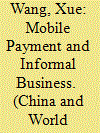| Srl | Item |
| 1 |
ID:
192416


|
|
|
|
|
| Summary/Abstract |
This study aims to answer two questions: What determines the adoption and use of mobile payment? What is the relationship between mobile payment and access to traditional bank services? By using representative survey data in rural China, we apply a hurdle model with 2SLS and find that consumers with better access to bank services are more likely to adopt mobile payment. However, after adoption, the less often the consumers visit banks because of distance or social constraints, the more they use mobile payment to complement bank services. Younger, better educated households with higher income and more smart phones are more likely to adopt and use mobile payment. Among these characteristics, age has the largest marginal effect while income has the least. Households in the agricultural sector are least likely to adopt and use mobile payment. We also find that awareness of neighbors' use of non-cash payment has a substantial positive effect.
|
|
|
|
|
|
|
|
|
|
|
|
|
|
|
|
| 2 |
ID:
187801


|
|
|
|
|
| Summary/Abstract |
The problem of high savings and low consumption of Chinese rural households has long been a source of concern. The popularity of mobile payments may help alleviate this problem. This paper examines the impact of mobile payments on household consumption in rural China by using data from the China Household Finance Survey (CHFS). To overcome the potential endogeneity, we use the instrumental variable (IV) and difference-in-differences (DID) methods and find a significant positive effect of mobile payments on rural household consumption. Mechanism analysis indicates that the positive impact of mobile payments is partially explained by the reduction in transaction costs, the easing of liquidity constraints, and the decrease in mental accounting loss. Furthermore, we verify the inclusive function of mobile payments through heterogeneity analysis and find that they play a greater role in promoting rural household consumption, especially for socially vulnerable groups, such as the elderly, people on low incomes, and low education. Our findings contribute to the literature on consumer finance and inclusive finance and have important implications for other countries.
|
|
|
|
|
|
|
|
|
|
|
|
|
|
|
|
| 3 |
ID:
171895


|
|
|
|
|
| Summary/Abstract |
This paper uses household panel data to explore the impact of mobile payments on China's household business activity. Using a difference‐in‐difference fixed effect specification, I find that mobile payment users are more likely to operate small‐scale and self‐employed informal businesses. The impact of using mobile payment primarily derives from the transition of agricultural families to business owners and the development of informal businesses. The paper illustrates an associated increase in employment and income for family members, with more pronounced effects on low‐income and rural households. It also provides prima facie evidence of the increase in fund transfers, which is important for risk sharing that informal businesses may encounter.
|
|
|
|
|
|
|
|
|
|
|
|
|
|
|
|